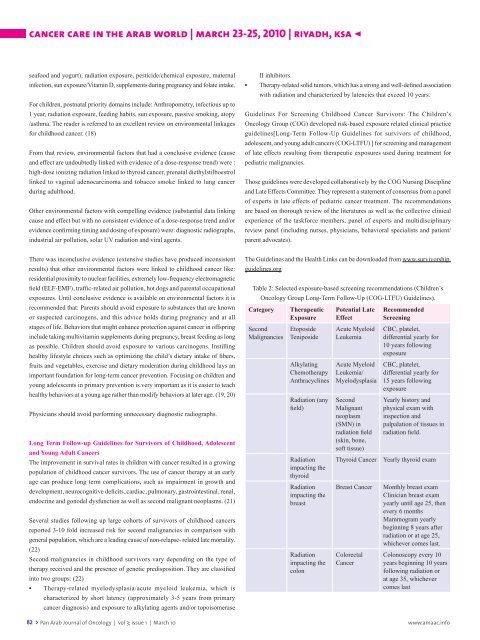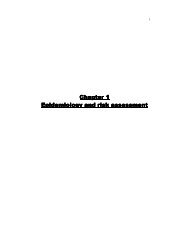Pan Arab Journal of Oncology - Arab Medical Association Against ...
Pan Arab Journal of Oncology - Arab Medical Association Against ...
Pan Arab Journal of Oncology - Arab Medical Association Against ...
You also want an ePaper? Increase the reach of your titles
YUMPU automatically turns print PDFs into web optimized ePapers that Google loves.
cancer care in the arab world | march 23-25, 2010 | riyadh, ksa <<br />
seafood and yogurt), radiation exposure, pesticide/chemical exposure, maternal<br />
infection, sun exposure/Vitamin D, supplements during pregnancy and folate intake.<br />
For children, postnatal priority domains include: Anthropometry, infectious up to<br />
1 year, radiation exposure, feeding habits, sun exposure, passive smoking, atopy<br />
/asthma. The reader is referred to an excellent review on environmental linkages<br />
for childhood cancer. (18)<br />
From that review, environmental factors that had a conclusive evidence (cause<br />
and effect are undoubtedly linked with evidence <strong>of</strong> a dose-response trend) were :<br />
high-dose ionizing radiation linked to thyroid cancer, prenatal diethylstilboestrol<br />
linked to vaginal adenocarcinoma and tobacco smoke linked to lung cancer<br />
during adulthood.<br />
Other environmental factors with compelling evidence (substantial data linking<br />
cause and effect but with no consistent evidence <strong>of</strong> a dose-response trend and/or<br />
evidence confirming timing and dosing <strong>of</strong> exposure) were: diagnostic radiographs,<br />
industrial air pollution, solar UV radiation and viral agents.<br />
There was inconclusive evidence (extensive studies have produced inconsistent<br />
results) that other environmental factors were linked to childhood cancer like:<br />
residential proximity to nuclear facilities, extremely low-frequency electromagnetic<br />
field (ELF-EMF), traffic-related air pollution, hot dogs and parental occupational<br />
exposures. Until conclusive evidence is available on environmental factors it is<br />
recommended that: Parents should avoid exposure to substances that are known<br />
or suspected carcinogens, and this advice holds during pregnancy and at all<br />
stages <strong>of</strong> life. Behaviors that might enhance protection against cancer in <strong>of</strong>fspring<br />
include taking multivitamin supplements during pregnancy, breast feeding as long<br />
as possible. Children should avoid exposure to various carcinogens. Instilling<br />
healthy lifestyle choices such as optimizing the child’s dietary intake <strong>of</strong> fibers,<br />
fruits and vegetables, exercise and dietary moderation during childhood lays an<br />
important foundation for long-term cancer prevention. Focusing on children and<br />
young adolescents in primary prevention is very important as it is easier to teach<br />
healthy behaviors at a young age rather than modify behaviors at later age. (19, 20)<br />
Physicians should avoid performing unnecessary diagnostic radiographs.<br />
Long Term Follow-up Guidelines for Survivors <strong>of</strong> Childhood, Adolescent<br />
and Young Adult Cancers<br />
The improvement in survival rates in children with cancer resulted in a growing<br />
population <strong>of</strong> childhood cancer survivors. The use <strong>of</strong> cancer therapy at an early<br />
age can produce long term complications, such as impairment in growth and<br />
development, neurocognitive deficits, cardiac, pulmonary, gastrointestinal, renal,<br />
endocrine and gonodel dysfunction as well as second malignant neoplasms. (21)<br />
Several studies following up large cohorts <strong>of</strong> survivors <strong>of</strong> childhood cancers<br />
reported 3-10 fold increased risk for second malignancies in comparison with<br />
general population, which are a leading cause <strong>of</strong> non-relapse- related late mortality.<br />
(22)<br />
Second malignancies in childhood survivors vary depending on the type <strong>of</strong><br />
therapy received and the presence <strong>of</strong> genetic predisposition. They are classified<br />
into two groups: (22)<br />
• Therapy-related myelodysplasia/acute myeloid leukemia, which is<br />
characterized by short latency (approximately 3-5 years from primary<br />
cancer diagnosis) and exposure to alkylating agents and/or topoisomerase<br />
II inhibitors.<br />
• Therapy-related solid tumors, which has a strong and well-defined association<br />
with radiation and characterized by latencies that exceed 10 years.<br />
Guidelines For Screening Childhood Cancer Survivors: The Children’s<br />
<strong>Oncology</strong> Group (COG) developed risk-based exposure related clinical practice<br />
guidelines[Long-Term Follow-Up Guidelines for survivors <strong>of</strong> childhood,<br />
adolescent, and young adult cancers (COG-LTFU) ] for screening and management<br />
<strong>of</strong> late effects resulting from therapeutic exposures used during treatment for<br />
pediatric malignancies.<br />
Those guidelines were developed collaboratively by the COG Nursing Discipline<br />
and Late Effects Committee. They represent a statement <strong>of</strong> consensus from a panel<br />
<strong>of</strong> experts in late effects <strong>of</strong> pediatric cancer treatment. The recommendations<br />
are based on thorough review <strong>of</strong> the literatures as well as the collective clinical<br />
experience <strong>of</strong> the taskforce members, panel <strong>of</strong> experts and multidisciplinary<br />
review panel (including nurses, physicians, behavioral specialists and patient/<br />
parent advocates).<br />
The Guidelines and the Health Links can be downloaded from www.survivorship.<br />
guidelines.org<br />
Table 2: Selected exposure-based screening recommendations (Children’s<br />
<strong>Oncology</strong> Group Long-Term Follow-Up (COG-LTFU) Guidelines).<br />
Category Therapeutic Potential Late Recommended<br />
Exposure Effect Screening<br />
Second Etoposide Acute Myeloid CBC, platelet,<br />
Malignancies Teniposide Leukemia differential yearly for<br />
10 years following<br />
exposure<br />
Alkylating Acute Myeloid CBC, platelet,<br />
Chemotherapy Leukemia/ differential yearly for<br />
Anthracyclines Myelodysplasia 15 years following<br />
exposure<br />
Radiation (any Second Yearly history and<br />
field) Malignant physical exam with<br />
neoplasm inspection and<br />
(SMN) in palpalation <strong>of</strong> tissues in<br />
radiation field<br />
(skin, bone,<br />
s<strong>of</strong>t tissue)<br />
radiation field.<br />
Radiation<br />
impacting the<br />
thyroid<br />
Thyroid Cancer Yearly thyroid exam<br />
Radiation Breast Cancer Monthly breast exam<br />
impacting the<br />
Clinician breast exam<br />
breast<br />
yearly until age 25, then<br />
every 6 months<br />
Mammogram yearly<br />
beginning 8 years after<br />
radiation or at age 25,<br />
whichever comes last.<br />
Radiation Colorectal Colonoscopy every 10<br />
impacting the Cancer years beginning 10 years<br />
colon<br />
following radiation or<br />
at age 35, whichever<br />
comes last<br />
82 > <strong>Pan</strong> <strong>Arab</strong> <strong>Journal</strong> <strong>of</strong> <strong>Oncology</strong> | vol 3; issue 1 | March 10 www.amaac.info









